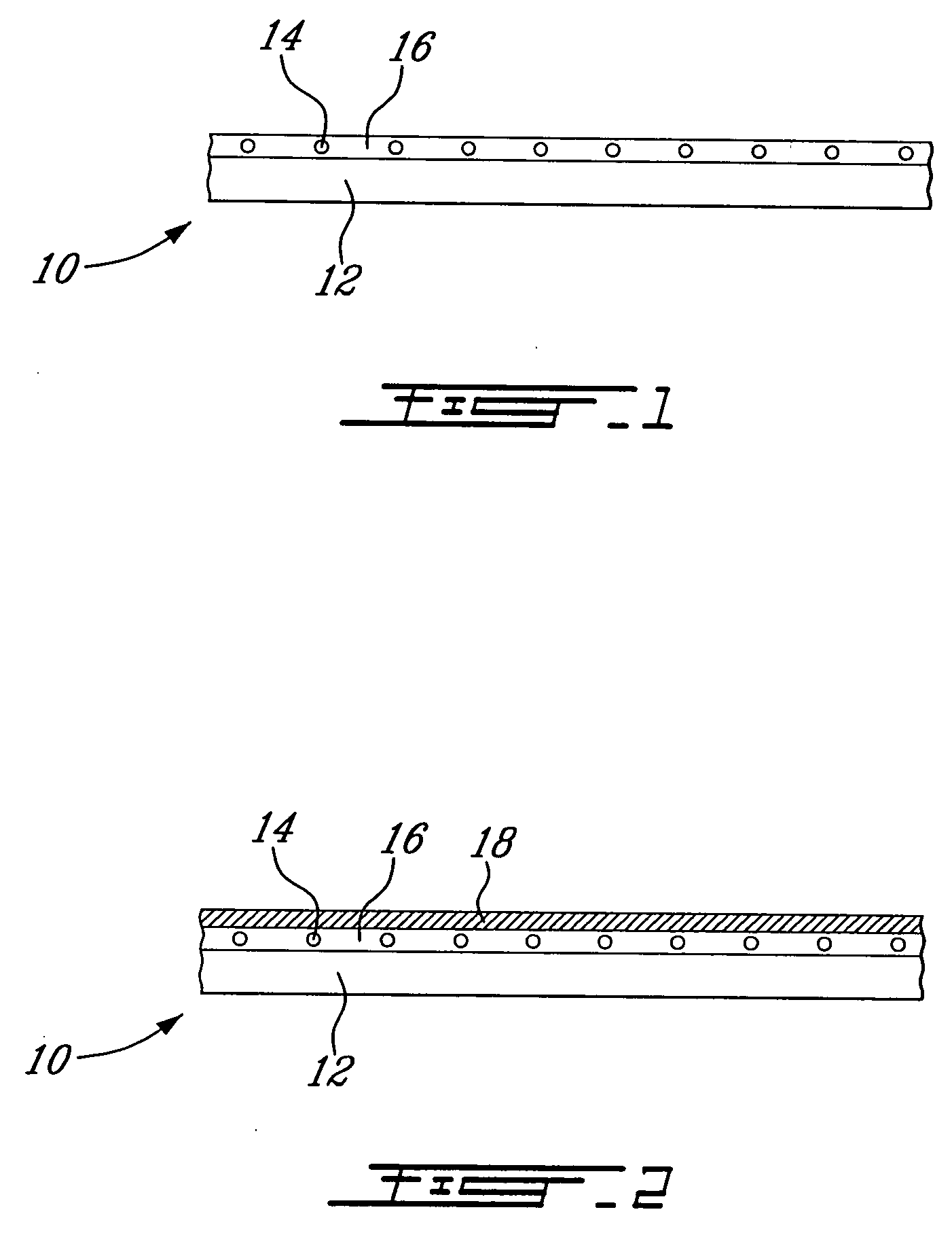Antimicrobial material
a technology of antimicrobial materials and antimicrobial agents, applied in biocide, plant growth regulators, weaving, etc., can solve the problems of high inhibition zone, material improper for medical or high-tech applications, limited antimicrobial activity of dressings, etc., to achieve improved surface distribution, reduce the surface energy of colloidal solution, and improve the effect of surface distribution
- Summary
- Abstract
- Description
- Claims
- Application Information
AI Technical Summary
Benefits of technology
Problems solved by technology
Method used
Image
Examples
example 1
[0103] A knitted polyester / carbon fabric (90 / 10) is passed through a bath containing a silver nitrate solution 0.2 M and then in a second bath containing a vinyl acetate emulsion into which dissolved sodium chloride is in excess 0.25 M which allows the formation of silver chloride colloid of a size range of 10-1000 nm. The silver chloride colloid dispersed into the vinyl acetate emulsion is subsequently squeezed inside the fabric using rubber laminated rolls before being dried on a finishing line to the temperature of 150° C. at a speed of 0.3 metre / minute. An electrically conductive, crocking resistant, antimicrobial fabric possessing antibacterial properties against gram negative and gram positive bacteria is obtained.
Surface resistivity, Ohm / square: <1
Crocking dry, 5-1: 4-5
Crocking humid, 5-1: 4
Inhibition, S. Aureus (presence or absence): presence
Inhibition, P. Aeruginosa (presence or absence): presence
Inhibition, E. Faecium (presence or absence): presence
Inhibition...
example 2
[0104] A knitted polyester / carbon fabric (90 / 10) is passed through a bath containing a silver nitrate solution 0.2 M and then in a second bath containing a solvent mix prepared in equal parts of water and ethanol (50:50% / vol) into which is dissolved sodium chloride is in excess 0.25 M which allows the formation of silver chloride colloid of a size range of 10-1000 nm. Also to this second bath is added a chlorinated organic compound, in the occurrence an organic compound known as Triclosan®. Chlorinated organic, non-leaching, antimicrobials agents of this type may be chosen from the group consisting of 2,4,4′-trichloro-2′-hydroxy diphenol ether and 5-chloro-2-phenol (2,4-dichlorophenoxy). The third bath contains a vinyl acetate emulsion. The silver chloride colloid dispersed into the vinyl acetate emulsion is subsequently squeezed inside the fabric using rubber laminated rolls before being dried on a finishing line to the temperature of 150° C. at a speed of 0.3 metre / minute. By admi...
example 3
[0105] A woven nylon fabric is passed through a bath containing a silver nitrate solution 0.2 M and then in a second bath containing 0.25 M sodium chloride solution which allows the formation of silver chloride colloids of a size range of 10-1000 nm. Also to this second bath is added a chlorinated organic compound, in the occurrence an organic compound known as Triclosan®. Chlorinated organic, non-leaching, antimicrobials agents of this type may be chosen from the group consisting of 2,4,4′-trichloro-2′-hydroxy diphenol ether and 5-chloro-2-phenol (2,4-dichlorophenoxy). The third bath contains a polyurethane emulsion. The silver chloride colloid dispersed into the polyurethane emulsion is subsequently squeezed inside the fabric using rubber laminated rolls before being dried on a finishing line to the temperature of 150° C. at a speed of 0.3 metre / minute. An electrically conductive, crocking resistant, antimicrobial fabric possessing domestic wash durability is obtained. Washing and...
PUM
| Property | Measurement | Unit |
|---|---|---|
| Size | aaaaa | aaaaa |
| Size | aaaaa | aaaaa |
| Size | aaaaa | aaaaa |
Abstract
Description
Claims
Application Information
 Login to View More
Login to View More - R&D
- Intellectual Property
- Life Sciences
- Materials
- Tech Scout
- Unparalleled Data Quality
- Higher Quality Content
- 60% Fewer Hallucinations
Browse by: Latest US Patents, China's latest patents, Technical Efficacy Thesaurus, Application Domain, Technology Topic, Popular Technical Reports.
© 2025 PatSnap. All rights reserved.Legal|Privacy policy|Modern Slavery Act Transparency Statement|Sitemap|About US| Contact US: help@patsnap.com



